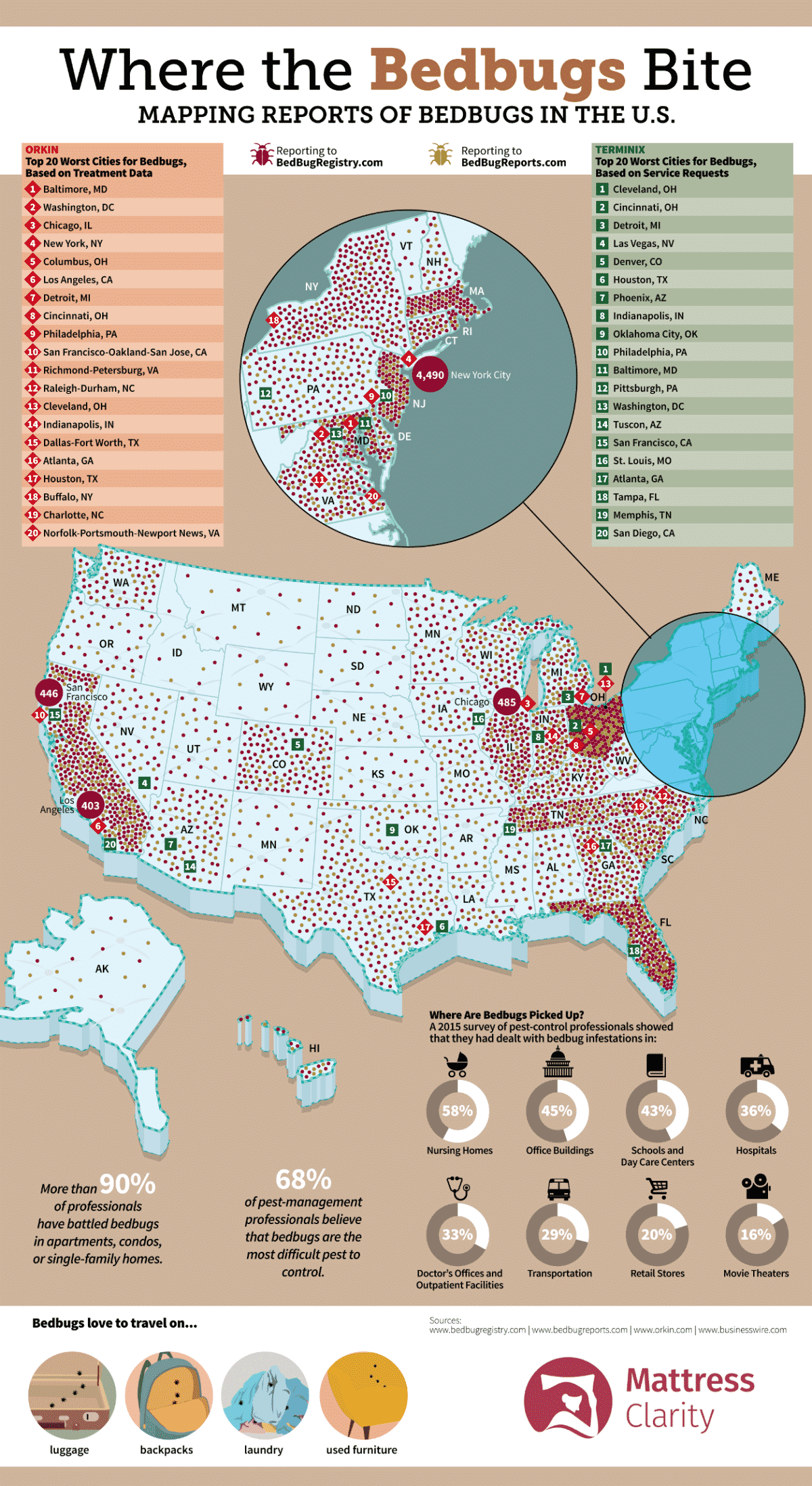
Like this infographic? Consider sharing it with this link or embed on your own site with the embed code below!
It seems like only a few years ago that the phrase “don’t let the bedbugs bite” was just a cute little saying whispered before sleep, devoid of any real threat. Thanks to a few pesticide-resistant strains of the critters, however, there’s been an explosive epidemic of bedbug infestations across the U.S.
We’ve created a U.S. bedbug infestation map to show how many reports have been submitted to The Bedbug Registry and BedbugReports.com by state, as well as the hot spots for popular pest-control companies Orkin and Terminix. The results of our bedbug report are pretty eye-opening.
What Are the Worst Cities and States for Bedbugs?
If you analyze our bedbug outbreak map, there’s not much consensus. The top bedbug cities tend to be repeat offenders on the eastern side of the country, such as New York City, Baltimore, Chicago, and Cleveland. New York City alone has more than 4,000 reports in the registry during the data collection period.
According to the numbers on our infographic, the worst states for bedbugs are consistently New York and California. Some states that have crawled up the ranks (pun intended) are Florida, Ohio, New Jersey, and Maryland.
What Are Bedbugs & How Do You Get Them in the First Place?
According to the U.S. Environmental Protection Agency, bedbugs are flat brown bugs with an oval-shaped body that is about the size of an apple seed. They feed on the blood of their hosts and leave itchy bite marks on behind on your skin. Since they are so small, they’re good at hiding in the creases of your mattress until they come out to feed at night. This makes them hard to find and even harder to eliminate from your house or apartment.
It may seem like they show up out of nowhere, but they tend to hitch a ride on clothing, luggage, used furniture, and laundry. Hotels, hospitals, office buildings, and nursing homes are their favorite spots. The data on our infographic suggests that the hardest-hit areas tend to have many hotels.
The EPA suggests that the increase in bedbug infestations may be attributed to a few factors, including:
- Increased travel to and from the U.S.
- Lack of knowledge about bedbugs and their prevention
- Poor extermination practices
- An increase in pesticide resistance
How to Check for Bedbugs
If you’re concerned you may have bedbugs, you should first familiarize yourself with the early signs of bed bugs, including what the bugs look like and what their bites look like. You may notice small red or rust-colored stains on your mattress. This could be leftover blood from bites.
Make sure to inspect all areas of your room. Take a flashlight and a small thin object – like a credit card – and look at your mattress, especially the creases and crevices, your bed and the other furniture and bedding in your room. Look for more than just the bedbug itself, you should keep your eye out for eggs and molted skin or feces as well.
If you find something that you think might be a bedbug or eggs, put it in a plastic bag to show an expert who can confirm.
Individuals who do have bedbugs should contact a professional terminator who can walk you through exactly what you should do to prepare for extermination. There are some suggestions for DIY extermination but because bedbugs are so difficult to fully get rid of, we suggest seeking professional help.
Preventing Bedbugs
There are ways to protect your home and your bedding from bedbugs. One thing we love at Mattress Clarity is a mattress protector. Encasement mattress protectors are available that cover all six sides of your mattress and in many cases they allow you to seal off your mattress from bedbugs. These are called “bedbug-proof” mattress protectors. We highly recommend getting a mattress protector when you purchase a mattress.
If you like to use secondhand furniture or other used items, inspect them very carefully before bringing them into your home. The idea of a free mattress or box spring on the street might be alluring but those are prime homes for bedbugs.
Those who share a home with others need to be extra vigilant with their own space. Vacuum regularly and don’t leave clutter or piles of items lying around your room or rooms. These can be prime places for bedbugs to hide.
Finally, you probably want to avoid putting the mattress on the floor. This can increase the chances of bed bugs making a home in your mattress.

